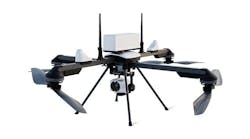FlightWave Leverages Tilt-pod, Thrust Vector, Autopilot & Power Management Technology for Superior Performance Tricopter
Drone technology is soaring to new levels of performance for commercial and industrial applications, as FlightWave Aerospace revolutionizes the flying experience. FlightWave engineers were able to rethink the Tricopter design — leveraging tilt-pod, thrust vector control, and customized autopilot technologies to solve a problem that has long vexed drone engineers.
The problem: Every other quadcopter by design literally has to fall out of the sky to reposition itself, dipping and compensating for the dip — over and over again. Falling while trying to move forward, back, left or right requires more energy to power up the opposing rotors to “catch” the fall. It’s a highly inefficient way to fly.
The solution: FlightWave achieves greater mission endurance by combining its tilt-pod, thrust vector, autopilot and power management systems. Here’s a breakdown of those critical pieces.
Tilt-pod
FlightWave’s tilt-pod technology is a collection of four major components — motor, motor controller, servo (required to tilt the motor) and a special power regulator (for the servo) — packed into one little pod that literally tilts the motor to point the thrust in different directions. The Tricopter design, with it oversized rear propeller, produces so much extra thrust from the main rear rotor, its easily provides more than enough lift for the aircraft to hover. Simultaneously, the two front tilt-pod rotors twist and turn the propellers, independently oscillating powering, providing the perfect amount of thrust to make precise movements without wasting energy.
Tilt-pods allow for a more stable flying experience, giving the pilot more control and confidence in tight places. Independently adjusting the tilt angle of the front propellers, makes the aircraft easier to command. Gliding into even very tight spaces with confidence, from indoor applications like warehouses and manufacturing plants, to outdoor missions where headwinds and lateral wind gusts require extra-strong performance.
Tilt-pod technology and the accuracy it provides has taken the drone to the next level of control. Being able to move without tilting the craft’s body allows for smooth flight. The ability to move without ‘upsetting’ the body of the aircraft allows for the successful use of many sensors and cameras once to sensitive for traditional drones. Someday this technology could be instrumental in transporting people as a smooth non-jarring flying experience is the key to passenger transport
Thrust Vector Control
Thrust vector control quite plainly is the ability to control a flying thing without control surfaces like wings or tail fins with flaps and ailerons. Thrust vectoring is primarily used in rocketry and is very complex as the air or space craft must make thousands of little adjustments per second to create the exact amount of thrust and direct it in a way as to control pitch and roll.
Thrust vectoring is really unusual even in manned aircraft, because it is very difficult to manage and do in a robust manner. It was first tested in rudimentary form on early aircraft more than 100 years ago. More recently and notably, it was implemented in the V-22 Osprey, a tilt-rotor military aircraft, which has vertical takeoff and landing (VTOL) capabilities. The design combines the functionality of a conventional helicopter with the long-range, cruising ability of a turboprop aircraft — something akin to what we have accomplished with our Edge Tricopter Hybrid Airplane.
Tilt-pod technology gives drones an incredible set of performance metrics, providing greater maneuverability and power — factors that are extremely important in a variety of use cases. Outdoors, the tilt-pod offers much better control in wind gusts and stronger performance through headwinds. It lets you fly on tough days when a standard quadcopter would have to stay grounded. Indoors, the tilt-pod delivers precision and control in tight spaces, where mere centimeters count.
Autopilot
Autopilots are the reason we love to fly. They make thousands of small corrections and adjustments automatically every second allowing the pilots to focus on the mission at hand.
FlightWave’s Tricopter design with the huge rear rotor is just one of the many keys to longer flight times. We needed to custom develop an autopilot that could utilize the huge fan in the rear for lift, while teaching the flight computer that it now had the ability to tilt its propellers forward and back for control. The result is a whole new flying experience making the Tricopter easy to use.
FlightWave’s proprietary autopilot software allows the operator to chart an entire course before the mission — including take off, navigation, steering, mission execution and return, without constant remote instruction after each task. This groundbreaking autopilot technology is accessible through a user interface on an integrated ground station controller — making it a first of its kind for a commercial UAS.
Power Consumption
The Tricopter’s power consumption is managed by a custom-engineered power management system, designed to sip energy. It’s so efficient, any traditional off-the-shelf batteries would be effective. However, FlightWave decided to design its own batteries perfectly powered, weighted, and positioned for center of gravity for best performance. The result is a purpose-built craft for serious commercial work.
FlightWave designed each of its drones with the combined tilt-pod, thrust vector, autopilot and power management technology for an entirely new flying experience. The aerospace company will be implementing these components in a new Tricopter craft, which will be available for purchase in 2020.

